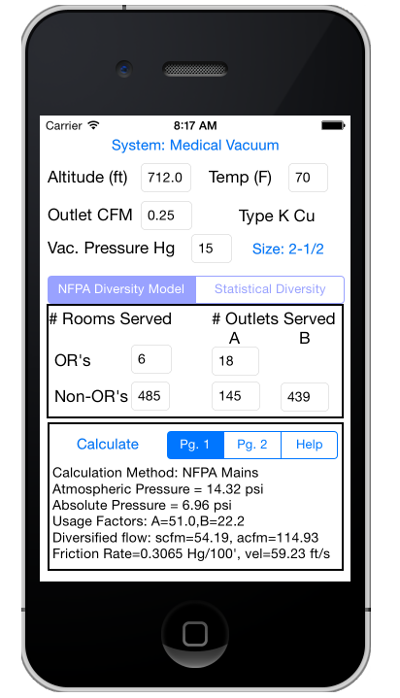Medical Gas – Iphone App
Medical Gas

This program is no longer available. It has been replaced by a new, more powerful version avalable here.
This program allows for the sizing of medical and dental vacuum and gas systems. To account for diversity, it uses statistical methods to estimate the diversity in usage of a group of outlets. When sizing vacuum systems, the program offers the option to use the diversity method outlined in NFPA 99.
NFPA 99 Medical Vacuum Sizing
The Medical Gas Pipe Sizing Program allows you to size vacuum systems using the procedures outlined in NFPA 99. To size a pipe, you enter in the number of outlets that the pipe ultimately feeds. By this, it is meant how many outlets are downstream of the pipe in question. Outlets are categorized as high usage (A), or low usage (B). You also enter in the number of rooms served, classifying each as Operating Room (OR), or non-Operating Room. When you select “calculate”, you will notice that the program will indicate which calculation method was used. For NFPA, there is a different method for branches as opposed to mains. An end branch will have a scfm calculated according to
1.5 cfm X Total Number of outlets
When serving more than one room, the calculation changes to the diversified “mains” equation. This “branch” calculation is also what is used when sizing feeds to OR’s. The equation for the mains becomes
0.25 cfm x NA x UFA + 0.25 cfm x NB x UFB + NOR
where
NA and NB are the number of A-types and B-type terminals, respectively,
UFA and UFB are the use factors for the number of A and B terminals,
and NOR is the number of Operating Rooms.
The NFPA method also has a peculiarity in that it recommends the use of the “branch” equations when serving up to six OR’s.
You will find that the iPhone App uses this logic when sizing by the NFPA method.
A word of caution! In the NFPA method, the calculations of scfm are performed on every leg of the pipeing network. There are cases where a “branch” calculation will produce a larger scfm than the adjacent “main” calculation. When this is the case, it is important to make sure the to carry the larger scfm downstream and override the “main” calculation. This is of course common sense, but something to watch out for when transitioning between “branch” and “main” categorized segments, especially when NFPA uses the “branch” calculation when serving up to six O.R.’s.With that in mind, the use of this app is most effective is one starts at the outlets, and runs a calculation on the segments, working his way back to the pump. The largest scfm calculated in any one segment must be carried back.** A website based version of the iPhone App is currently being developed as well.
